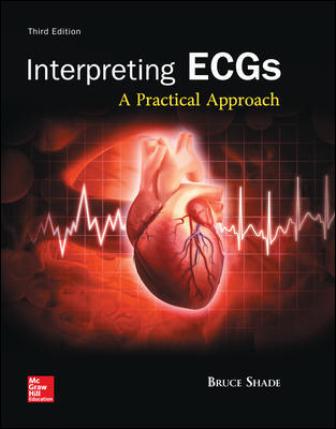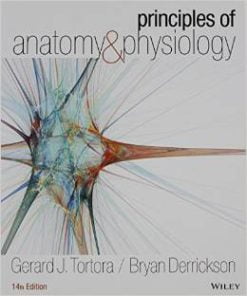Test Bank for Interpreting ECGs: A Practical Approach, 3rd Edition Bruce Shade
$55.00 Original price was: $55.00.$29.99Current price is: $29.99.
Test Bank for Interpreting ECGs: A Practical Approach, 3rd Edition, Bruce Shade,
Sell by: Stella Boyd
Category: Test Bank
Instant download Test Bank for Interpreting ECGs: A Practical Approach, 3rd Edition, Bruce Shade pdf docx epub after payment.

Product details:
- ISBN-10 : 1260017249
- ISBN-13 : 978-1260017243
- Author: Bruce Shade
Interpreting ECGs: A Practical Approach, Third Edition uses an easy-to-understand, how-to approach to develop solid ECG analysis and recognition skills. Learn how to measure waveforms, segments and interval durations to determining heart rates and types of irregularity.
Table of contents:
- Section 1: Preparatory
- Chapter 1 Anatomy and Electrophysiology of the Heart
- The Electrocardiogram
- How It Works
- The Circulatory System
- Anatomy of the Heart
- Shape and Position of the Heart
- The Pericardial Sac
- The Heart Wall
- The Internal Heart
- Cells of the Heart
- Myocytes
- Pacemaker and Electrical Conducting Cells
- The Heart’s Conductive Pathway
- SA Node
- AV Node
- Bundle of His and Right and Left Bundle Branches
- Purkinje Fibers
- The Heart’s Blood Supply
- Right Coronary Artery
- Left Main Coronary Artery
- Coronary Veins
- Physiology of the Heart and Circulation
- The Cardiac Cycle
- Cardiac Output
- Blood Pressure
- Blood Flow through the Atria
- Initiation of Impulse in the SA Node
- Atrial Depolarization and Contraction
- Conduction through the AV Node
- Conduction through the His-Purkinje System
- Ventricular Depolarization and Contraction
- Atrial and Ventricular Repolarization
- Alternate Pacemaker Sites
- Influences on the Heart and Circulatory System
- The Autonomic Nervous System
- Sympathetic Nervous System
- Parasympathetic Nervous System
- Increased Myocardial Oxygen Needs
- Nerve Impulse Generation and Muscle Contraction
- Polarized State
- Depolarization
- Repolarization
- Refractory Periods
- Impulse Generation of the SA Node
- Depolarization and Repolarization of the Myocytes
- Chapter 2 The Electrocardiogram
- The Electrocardiogram and ECG Machines
- ECG Lead Wires and Electrodes
- Lead Wires
- Electrodes
- Heart’s Normal Electrical Activity
- ECG Leads
- Bipolar/Unipolar Leads
- Planes of the Heart and Lead Placement
- Frontal Plane
- Horizontal Plane
- Putting the Views Together
- 15- and 18-Lead ECGs
- Displays and Printouts
- Reading Printouts
- Section 2: The Nine-Step Process
- Chapter 3 Analyzing the Electrocardiogram
- Characteristics of the Normal ECG
- Analyzing the Electrocardiogram Using the Nine-Step Process
- Step 1: Heart Rate
- Step 2: Regularity
- Step 3: P Waves
- Step 4: QRS Complexes
- Step 5: PR Intervals
- Step 6: ST Segments
- Step 7: T Waves
- Step 8: QT Intervals
- Step 9: U Waves
- Flexibility in the Nine-Step Process
- Dysrhythmia and Cardiac Condition Characteristics
- Analyzing the ECG
- Analyzing the Rhythm Strip
- Analyzing the 12-Lead Tracing
- Calibrating the ECG
- Artifact
- Chapter 4 Heart Rate
- Importance of Determining the Heart Rate
- Quick Check of the Heart Rate
- Heart Rates Seen with Various Dysrhythmias
- Methods of Determining Heart Rate
- 6-Second Interval × 10 Method
- 300, 150, 100, 75, 60, 50 Method
- 1500 Method
- Rate Calculators
- Counting Both the Atrial and Ventricular Rates
- Normal, Slow, and Fast Rates
- Slow Rates—Bradycardia
- Fast Rates—Tachycardia
- Stable or Unstable, Narrow or Wide
- Chapter 5 Regularity
- Importance of Determining Regularity
- Quick Check of Regularity
- Methods of Determining Regularity
- Paper and Pen Method
- Caliper Method
- Counting the Small Squares Method
- Using a Rate Calculator
- Types of Irregularity
- Occasionally or Very Irregular
- Slightly Irregular
- Irregularity Caused by Sudden Changes in the Heart Rate
- Irregularly (Totally) Irregular
- Patterned Irregularity
- Irregularity Caused by Varying Conduction Ratios
People also search:
Interpreting ECGs: A Practical Approach, 3rd Edition
Interpreting ECGs: A Practical Approach, 3rd Edition pdf
Interpreting ECGs: A Practical Approach
how to interpret ecg easily
|
a practical guide to ecg interpretation pdf
|
understanding ecg interpretation
Related products
Sale!
Test Bank
Test Bank for Operating Systems: Internals and Design Principles, 7th Edition: William Stallings
Sell by: Cole Freeman
Sale!
Sell by: Michael Johnson
Sale!
Sell by: Joshua Sanchez
Sale!
Sell by: Madison Foster
Sale!
Sell by: Nora Patterson
Sale!
Sell by: Trevor Lawrence
Sale!
Sell by: Benjamin Young
Sale!
Sell by: Steven Russell











